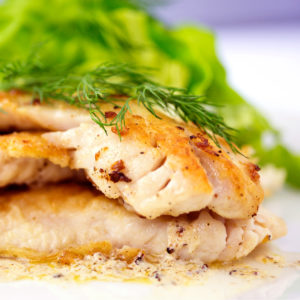Butterfish
QUICK FACTS
Nutrition Value: Protein, Sodium, Omega 3, Vitamins A, B1,B2,B3,B5,B6,B9,B12, Iron, Calcium, Copper, Magnesium, Phosphorus, Potassium, Selenium, Zinc
Ways to cook: Pan-fried, Grilled, Baked, Baked, Roasted
Portion Sizes: 150 – 200g
Taste: Butterfish have a delicate, buttery flavour. Because of their small size, butterfish are almost exclusively sold whole
Sides Suggestions:
- Lemongrass, Ginger & Lime Butter Fish Parcels
- Garlic Butter Fish with Cous-cous & Greek Salad
- Oven Roasted Atlantic Butter Fish with Fennel
- Baked Butter Fish Saratoga
- Brawn Butterfish Florentine
- Misoyaki Butter Fish
- Pan Grilled Butter Fish with Salsa Verde & Bruschetta
- Caribbean Butter Fish in Butter Sauce.
Similarities: Cod, Tuna, Salmon, Mackerel
To Drink with Butterfish: Chardonnay, Sauvignon Blanc, Chenin Blanc.
Best way to cook
Pan-frying: You can choose to fry your fish as is or cover it in flour or breadcrumbs. Using the extra coating will give your fish more texture and body. If you’re going to dip it in flour, soak the fish in a bowl of milk for 3 to 5 minutes, before covering it in flour or breadcrumbs. This will help the coating stick to the fish.
Get your pan ready for frying by pouring a few tablespoons of vegetable oil into it. You can also use clarified butter which will taste great on the fish. Heat the pan until the oil slides around easily. You can splatter a few drops of water in the pan – if the water sizzles, it’s ready for your fish. Place the fish flesh side down in the pan – the side you’ll be presenting to your diner (the non-skin side).
Once your fish is in the pan, slide a spatula gently underneath to prevent it from sticking. Cook the fish for 3 to 4 minutes on one side and then flip it. Fish usually cooks for 10 minutes per inch of thickness. Use a wide spatula to prevent breaking the fish. Cook for another 3-4 minutes or until the flesh turns pearly white and flakes easily with a fork. Carefully lift it out of the pan and serve immediately.
Grilling: Grilling fish gives you a great advantage as you have complete control over the temperature. Always coat your fish with oil or fat to prevent sticking. As you’re heating your grill, cover the grate loosely with aluminium foil. The intense heat will cause any residue to dissolve, starting the cleaning process for you. This also minimizes sticking.
Blast the heat to 288°C. Remove the aluminium foil. Using a grill brush, scrape the grate clean. Fold a few sheets of paper towels into a small pad, dip them in oil using tongs and rub over the bars of the grate until it looks glossy.
Choose fillets that are thick and sturdy for grilling and can stand up to the intense heat of a live fire. Cut your fish into portions that have an even thickness to ensure you don’t have any dry or undercooked parts. Coat your fish with some olive oil, salt and pepper and place it skin-side down and diagonally on the grill.
This makes it easier to flip the fish as it’s lying on an angle. The fish will take 8 minutes to cook through per inch of thickness, taking about 3-5 minutes per side. Reduce the heat to medium, cover the grill and let it cook. When cooked properly, the meat will be firm to the touch, flake easily with a fork and appear opaque all the way through.
Oven baking: Baking fish in the oven enables you to control the cooking temperature and limit how much you handle the fish, preventing it from overcooking or falling apart.
Season fillets with pepper, dip in egg and coat in bread crumbs. Preheat the oven to 275°C and line a baking tray (glass or metal) with aluminium foil. Brush with olive oil. Arrange the individual fish fillets on the baking tray in a single layer. Don’t allow the fish fillets to overlap one another. Bake in the pre-heated oven for 15 to 25 minutes or until the fish flakes easily, basting frequently with butter.





